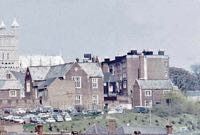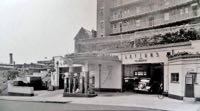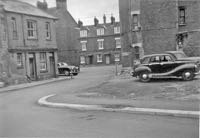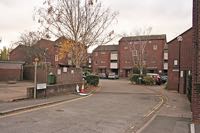
Mermaid Inn – West Quarter
Page updated 13th March 2019
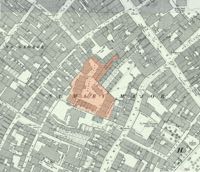 The Mermaid Inn, between Preston Street and Coombe Street, was one of the most prominent inns within Exeter from about the 14th Century until the beginning of the 19th Century. It prospered as a hostelry, and then as an important departure point for a number of flourishing carrier businesses during the 18th Century, that served London and many local destinations. At one point, it was almost equal to Exeter's premier New Inn, that was in the High Street.
The Mermaid Inn, between Preston Street and Coombe Street, was one of the most prominent inns within Exeter from about the 14th Century until the beginning of the 19th Century. It prospered as a hostelry, and then as an important departure point for a number of flourishing carrier businesses during the 18th Century, that served London and many local destinations. At one point, it was almost equal to Exeter's premier New Inn, that was in the High Street.
The site was excavated by the Exeter Museums Archeological Unit in 1977/78. They uncovered extensive evidence of Roman, military occupation. They had undertaken tree removal, indicating that it was a wooded area before their arrival. Apart from Roman Samian ware finds, the earliest pottery uncovered was from about 1150, including a large, but crude pitcher. They also found evidence of the city's late medieval foundry, run by Robert Newton from 1423, including parts of clay-loam moulds from which bells and domestic metalwork such as cauldrons and skillets were cast. The bell of St Pancras Church is from this foundry.
The inn, accessed from Preston Street, had a large yard and stables that could cater for many packhorses and coaches. It was a large, sprawling building, with extensive cellars. The building had a large oak staircase with a carved handrail and an assembly room, measuring 56ft by 17ft. It had an arched and moulded ceiling, "enriched with gold and colour", and a stone chimneypiece dated 1632, adorned with the arms of the Shapleigh and Slanning families. The assembly room and other large rooms were frequented by wealthy guests, and balls were often hosted by the inn. In addition to the spacious yard, for pack horses, and carriages, there was a large garden with a summer house, giving views to distant fields and hills.
According to Dr Oliver, an old book tells of how, there was once a long discussion on the choice of sign, which ended on the selection of the "Mermaid," because, said the hostess, "she will sing catches to the youths of the parish." It was recorded as the Mairemead Inn 1666, although its history went back much further. What is certain, is that the earliest known depiction of a Mermaid, in England, dates from about 1078.
The yard for the Mermaid Inn also served for other purposes than the inn. It was here that Robert Newton ran a bell foundry in 1423, when he was made a freeman of the city–he was still casting bells in the 1440s. Many Devon churches still have bells produced by the foundry, including St Pancras', in the Guildhall centre. There is also archeological evidence from fragments of clay-loam moulds that domestic cauldrons and skillets were cast at the same foundry.
Prayer Book Rebellion
During the Prayer Book Rebellion of 1549, Sir Thomas Denis, Sir Hugh Pollard, and Mr. Yard, negotiated with the mostly Cornish rebels, at Clyst St Mary, and came away thinking they had done enough to placate them. The negotiators, along with Sir Peter and Sir Gawen Carew, a company of knights, squires and justices, rode into Mermaid Yard, after the talks. After supper, Sir Peter and Sir Gawen Carew probed the negotiation team on the settlement, and when the terms were given, they thought that too many concessions had been made by the King. The meeting ended in acrimony, before the negotiators left the inn–most were later captured by the rebels and held for several weeks. Sir Peter and Sir Gawen remained at the inn.
The rebels put Exeter under a siege, and it was not until four weeks later, that Lord Russell faced the rebels at Clyst St Mary, and after a long fight, prevailed. Sir Peter and Sir Gawen Carew were awarded, by King Edward, large estates across Devon and Cornwall.
Cock fighting
Away from rebellions, the Mermaid was a popular place for cock fighting, and Cathedral clergy, at the same time. In April 1677 the Dean and Chapter had to deal with a vicar, two lay vicars and another who were caught for attending a cock fight, when they should have been at a service.
The four "Acknowledged and confessed that they were present at the said Cock-fighting and that some of them were there in tyme of Divine Service and submitted themselves. Whereupon the President and Chapter Admonished them......to forbeare and avoyde such meetings and not to be present at any Cockfighting for the future."
Carrier service
The inn did good trade with carriers and travellers through the 18th and first half of the 19th Century, stabling and feeding their animals. In 1729 a receipt was issued with the charges for one night:
The Moreton Carrier, for ten penny horses - 0s 10d
Mr. Slade, the Yeovil Carrier, for 7 horses - 3s 6d
Mr. Withicum, Ashburton Carrier, 17 horses - 8s 6d
Mr. Withicum, Totnes Carrier, 13 horses - 6s 6d
Mr. Randall, Okehampton Carrier, 9 horses - 4s 6d
Muchmore, for one night for his horse - 0s 6d
Before 1747, from the Mermaid Inn, a company called Iliffe's Flying Van, owned by Edward Iliffe, in partnership with Thomas Parker of the New Inn, ran a passenger carriage known as a 'machine', every Monday to London, taking two days for the journey. Iliffe also ran fly wagons which carried goods every Monday, Tuesday and Thursday, in four and a half days, and in 1747, Iliffe had 126 horse and 14 wagons. Iliffe sold the "Mermaid," about the year 1810, to Thomas Bury, a wool-stapler, who built a house in the yard.
The inn continued to trade into the 19th Century. This advert appeared in the Flying Post in 1833.
MERMAID INN. PRESTON-STREET. BENJAMIN RICHARDS, impressed with gratitude his numerous Friends for the Favors conferred on him at the SPREAD EAGLE INN, begs to inform them and the Public in general, that he has TAKEN AND ENTERED ON THE ABOVE PREMISES, where he hopes, by keeping the best, Wines and Spirits, Home-brewed Beer, Well-aired Beds, & c., to merit a continuance of their kindness. WINES, SPIRITS, AND CORDIALS, RETAIL. Dated Exeter, October 9th, 1833.
In 1844, the Exeter Brewery acquired Mermaid Yard, and the next year, the brewery was sold to John Evomy Norman, of the City Brewery, when the Mermaid was listed as a leasehold property with stable. Once the railway was firmly established in Exeter, the need for an extensive carrier service reduced, with a few services surviving to parts of Devon not served by the railway. John Marks appears to be the last landlord of the Mermaid Inn, when it was referred to as "Mark's Mermaid Inn." Through the 1850s and 60s, there were cases of drunkenness, fighting and theft appearing at the Guildhall, all of which occurred at the Mermaid. The clientele of the district was no longer the weary traveller, nor the gentleman, but the inhabitants of the overcrowded, poor tenements.
Then on the 17 June, 1869, this bankruptcy notice appeared in the Exeter and Plymouth Gazette.
AUCTION THIS DAY, BANKRUPTCY. MERMAID INN, PRESTON STREET, EXETER. MESSRS. NORRIS and SON, instructed by the Creditors' Assignee, will SELL by AUCTION, this day Thursday, 17th June, 1869, all the HOUSEHOLD GOODS and FURNITURE, Business Utensils and Fixtures, four-motion Beer Engine and Pipe, copper brewing furnace, store casks, the usual brewing utensils, copper pump, about 50 hhds. of prime old beer, two pockets of hops, malt bruiser, and other effects without Reserve. Sale to commence at Eleven o'Clock precisely. Auction Offices, 21, South Street.
The end of the Inn but the Yard lives on
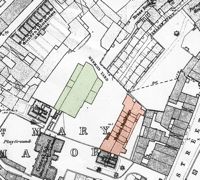 The City of Exeter Improved Industrial Dwellings Company was formed in 1873, for 'providing commodious and healthy dwellings for the poor classes'. They purchased two sites, one being in Blackboy Road that would become Kendall's Buildings, and the second site was Mermaid Yard.
The City of Exeter Improved Industrial Dwellings Company was formed in 1873, for 'providing commodious and healthy dwellings for the poor classes'. They purchased two sites, one being in Blackboy Road that would become Kendall's Buildings, and the second site was Mermaid Yard.
The brewing plant and machinery came up for sale by auction in July 1873. The equipment comprised furnaces, cisterns, a dome brewing copper, weights and chains, liquor and hop backs, mash tubs, coolers, malt backs, casks and piping. In addition, stone, bricks, frames, doors and other parts of the building were for sale.
They paid £3,500 for the site and £800 for building materials, of what was, according to reports, in the centre of an overcrowded, warren of tenements. The fine staircase, and plaster mouldings, still existed, for those who cared to find them, within the tenements.
Follett's Buildings, was the first of three blocks to be constructed, each of twenty-four tenements. The first to open was Follett's (tinted red on the map) in November 1874. Each tenement had between two and four rooms, with larder, scullery, water supply, coal cellar and water closet. Cotton's Building (tinted green) followed, soon after, but the third was never constructed.
Mermaid Inn no longer existed, although the yard between the tenement blocks were still referred to as Mermaid Yard.
All that remained of the Mermaid Inn, were the cellars, which survived into the last century. They were accessed from a cliff face behind Gayton's Garage, in Coombe Street, and were used as a wine and spirit store and, later, an air raid shelter in the Second World War.
Sources: Victorian Exeter by Robert Newton, the Flying Post, Exeter and Plymouth Gazette, Memorials of Old Devon, various street directories and other articles on Exeter Memories. Exeter Cathedral Archives.
│ Top of Page │
